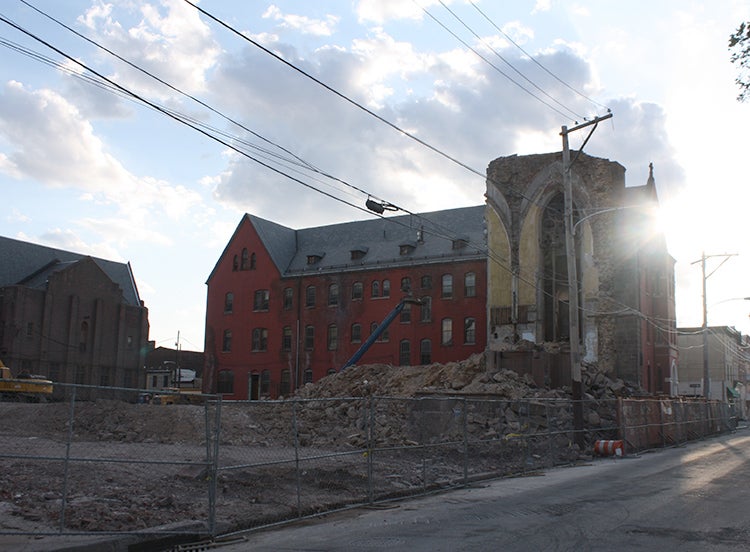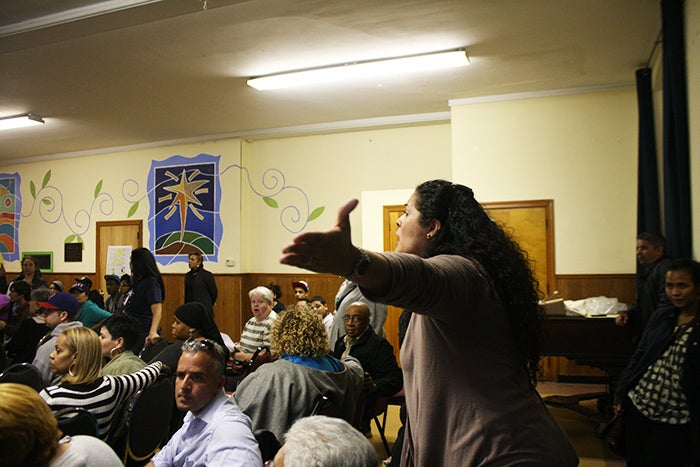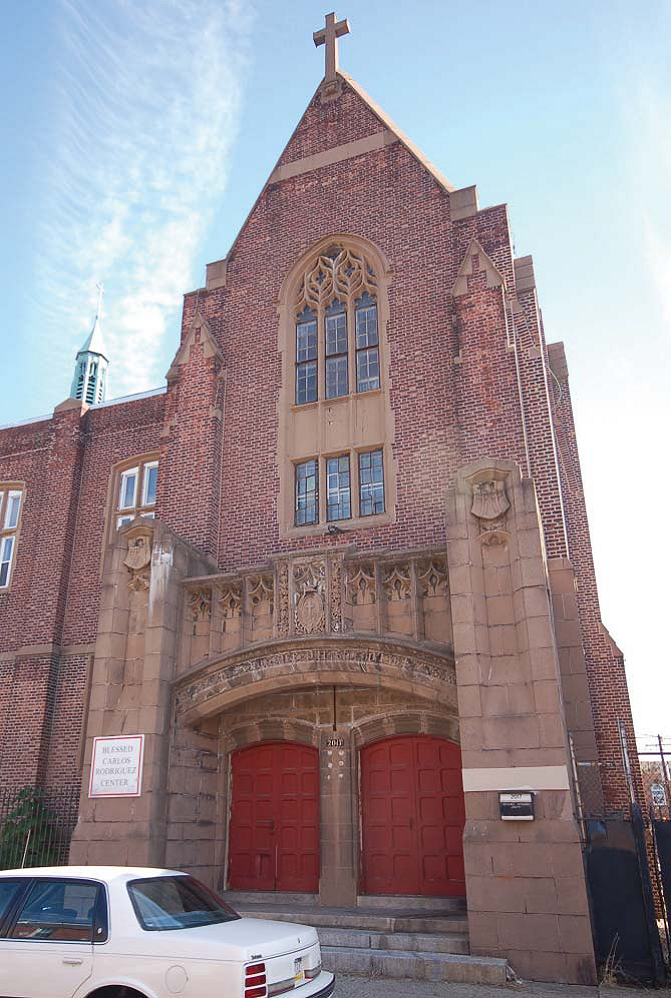Council zoning bill would stymie St. Boniface development
Note: This article contains a clarification. Councilwoman Sánchez’s bill would affect hundreds of parcels in Norris Square; the original version of this article said it would only affect around thirty. PlanPhilly regrets the error.
Three weeks ago, Councilwoman Maria Quiñones-Sánchez, of the 7th District, introduced a bill into City Council which would change the zoning designations of certain parcels within a five-block stretch of Kensington.
Between York, Norris, Front and 2nd streets, every parcel designated R10—a multi-family residential classification—would be switched to R10A, a single-family classification. If the bill passes, the affected parcels will remain single-family residential when the new zoning code goes into effect this summer. To convert any such parcel to multi-family, the owner would have to obtain a variance. If it does not pass, any building currently classified as R10 will be able to house multiple units by right.
Councilwoman Sánchez says she introduced the bill because she’s concerned about the number of conversions from single-family to rental units in the neighborhood, and about their ramifications for density and parking.
This past Monday night, Sánchez and members of the Planning Commission held a community meeting at West Kensington Ministry at Hancock and Susquehanna streets to discuss the zoning change. The meeting was intended to inform the community about the impact of the zoning change, and to inform the Planning Commission, which will make a recommendation on the bill at its next meeting, about the community’s attitude toward the switch.
The meeting was by turns contentious and chaotic, and not at all a simple explanation of what it means to switch from R10 to R10A.
Because while the zoning change would apply to many parcels in the Norris Square neighborhood, it seems to have been prompted by one in particular: the site of the former St. Boniface church, along with several smaller buildings, at the corner of Hancock and Diamond streets.
St. Boniface has been owned by Norris Square Civic Association (NSCA) since 2007, when NSCA acquired it from the Redemptorists of the Baltimore Province. The church was closed in 2006.
NSCA has worked over the past few years to redevelop the site, and the church building at the corner of Diamond and Mascher was recently demolished. The group plans to build a 15-unit, Limited Equity Housing Co-op (LEHC) with off-street parking on that corner (see renderings attached). As members of the LEHC, residents of the development would own their units, but the amount they’d be able to sell them for would be limited.
Since the parcel is R10, Sánchez’s bill would switch its designation to single-family only, and require NSCA to get a variance from the Zoning Board of Adjustment in order to build the multi-unit project.
Maria Camoratto, director of real estate development for Norris Square Civic Association, said she was “shocked” and “heartbroken” by Sánchez’s introduction of the zoning change.
“It is a complete threat to the project,” Camoratto said.
For her part, Sánchez admits that she introduced the zoning bill in response to NSCA’s plans for the St. Boniface site.
“I have to be completely honest and say, yes, [the bill] was triggered by [the plans for St. Boniface] …” Sánchez said.
Sánchez said she felt NSCA was moving ahead without broad support from or outreach to the community, and she wants the project to be reviewed by the ZBA.
“[There] is great concern among my neighbors that this project could be harmful to the neighborhood,” Sánchez wrote in an email. “There is concern about over-use, there is concern about the character of the neighborhood, there is concern about the aesthetics of the design. There are also residents of Norris Square who support it. It’s ok for people to disagree on a project like this, I just don’t think it makes sense to have the developer (the party with the largest financial stake in the project), to be the sole determiner of what the community wants or needs.”
NSCA insists that the project does have the community’s support. Camoratto said the group has collected “hundreds” of signatures on a petition supporting its plans for St. Boniface. She also said the group went door-to-door to the houses surrounding Norris Square after a meeting in February to ask residents what they thought of the project.
“From what I understand, we had very positive and significantly good feedback” on both the petition and the door-to-door campaign, Camoratto said.
She added, “The intent is to do something positive for the community.”
NSCA’s funding for the project comes from a handful of sources. In 2011, the group received $5 million from a state Redevelopment Assistance Capital Program (RACP) grant. That program requires dollar-for-dollar match funding from a non-state source. Norris Square Civic Association also received part of a grant for more than $137 million given to a consortium of 16 Latino community organizations through the Neighborhood Stabilization Program 2, an initiative of the U.S. Department of Housing and Urban Development. Camoratto said NSCA is using the Neighborhood Stabilization money to match the RACP grant.
Sánchez said those funds could be put to better use.
“Why are we spending $5 million in federal neighborhood stabilization funds to build just 15 new units when for much less we could preserve and restore the dozens of abandoned buildings that fill this neighborhood?” said Sánchez, who co-introduced Land Bank legislation with Councilman Bill Green earlier this year.
“There is an incredible amount of stress consistently put on community outreach and letting the community know” what NSCA is doing, Maria Camoratto said. And she emphasized that the community is behind the St. Boniface project.
But, she added, “We can only respond to the feedback we get.”
Asked who specifically was raising concerns about the St. Boniface development, Councilwoman Sánchez repeated: “my neighbors …”
Sánchez says that the zoning change currently before Council is intended to be part of a more comprehensive remapping of neighborhoods in her district.
“This legislation is bigger than any individual parcel or proposal,” Sánchez said. “However, I, like many of my fellow Norris Square residents, feel that this project is an overuse of the site, and does not support the character of the neighborhood.”
Both Maria Camoratto and Patricia DeCarlo, executive director of NSCA, said they feel they’ll still be able to complete the St. Boniface project whether Sánchez’s bill passes Council or not.
“We have an excellent relationship [with the ZBA],” said Camoratto, “an excellent history of gaining variances we need for projects.”
Of course, given City Council’s tendency to go along with any development-related bill introduced by a District Councilperson, the zoning change is likely to pass, whether the Planning Commission favorably recommends it next week or not. Sánchez told PlanPhilly she would not support NSCA’s application for a variance for the St. Boniface project, if it comes to that.
At Monday’s meeting, during which at least as many people were there to find out what the zoning change would mean as were there to support NSCA’s St. Boniface project, Councilwoman Sánchez said she would reprint the community notices in Spanish as well as English and hold another meeting in two weeks.
“Chaos prevents clarity,” Sánchez said. “More people didn’t speak [at the meeting] than the ones who spoke, and those were the people I was there for.”
Camoratto, on the other hand, argued that the intention of the bill was so clear that the community couldn’t help but use the meeting to talk about St. Boniface.
“Maybe this zoning thing is right for us, and maybe it isn’t,” Camoratto said, “but it’s hard to talk about when there’s this elephant in the room.”
The Planning Commission will consider the bill next Tuesday, April 17th, at 1 p.m. on the 18th floor of 1515 Arch St. Check PlanPhilly for details on a second community meeting about the bill.
Contact the reporter at jaredbrey@gmail.com and follow him on Twitter @jaredbrey
WHYY is your source for fact-based, in-depth journalism and information. As a nonprofit organization, we rely on financial support from readers like you. Please give today.







